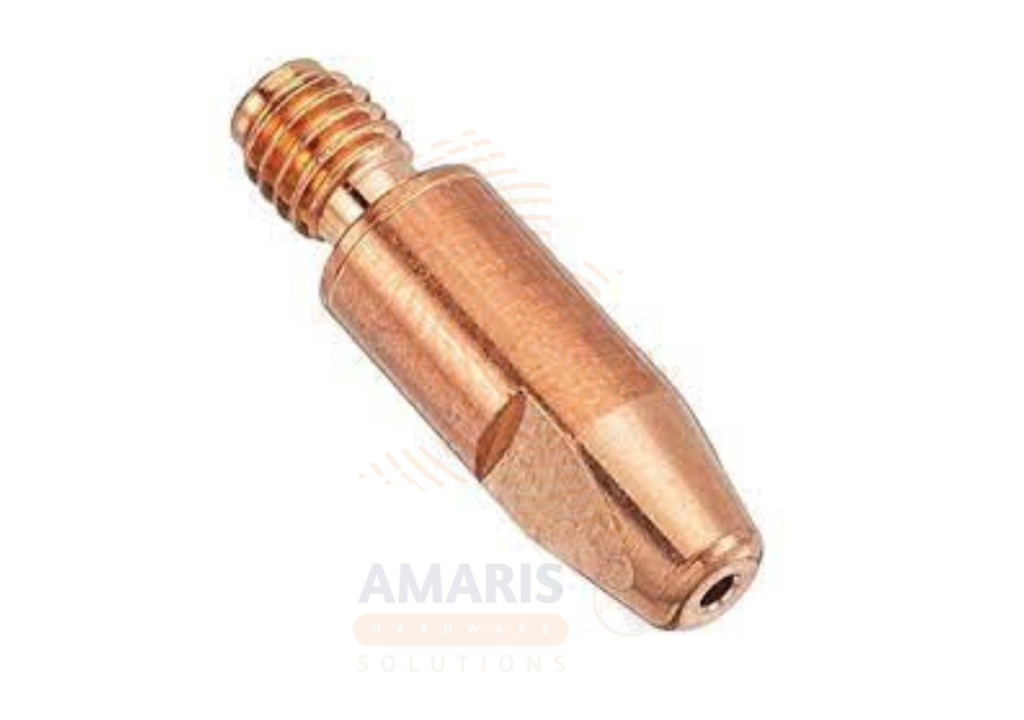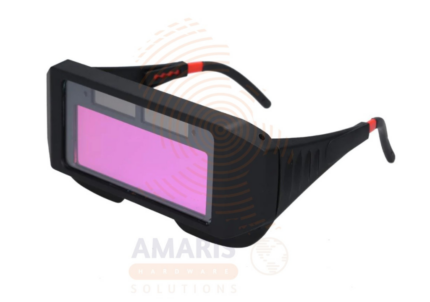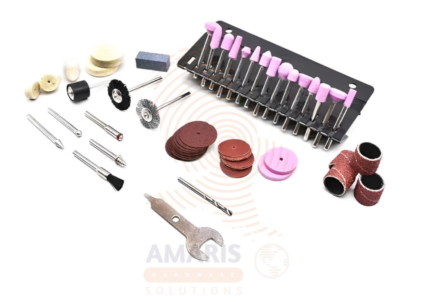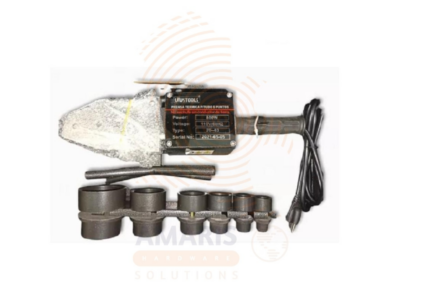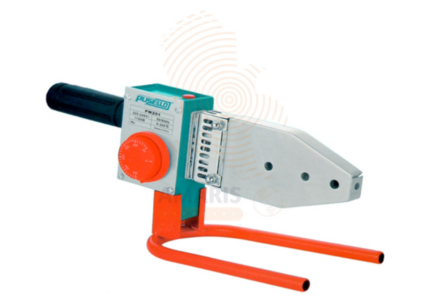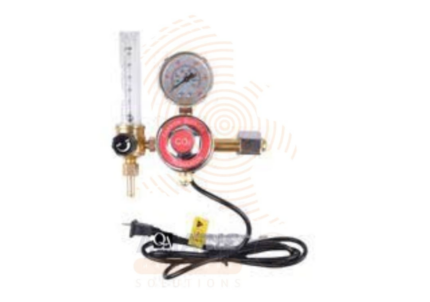M8 Tips for MIG Welding Torch
$12.15 Original price was: $12.15.$11.54Current price is: $11.54.
WhatsApp Order
M8 Tips for MIG Welding Torch, or Metal Inert Gas welding torch, is a handheld device used in the MIG welding process. It consists of a handle, trigger, and a nozzle through which a consumable electrode wire is fed. The torch is connected to a welding power source that generates an electric arc between the wire and the workpiece, melting the wire and creating a weld. The torch also incorporates a shielding gas, typically a mixture of inert gases, to protect the weld from atmospheric contamination. MIG welding torches are versatile tools widely used for their ease of operation and efficiency in joining various metals.
Description
Table of Contents
ToggleM8 Tips for MIG Welding Torch
Uses
-
Automotive Fabrication and Repair:
-
MIG welding is commonly used in the automotive industry for tasks such as repairing body panels, fabricating exhaust systems, and assembling various components.
-
-
Construction and Structural Welding:
-
MIG welding is employed in construction for joining structural components, such as beams and columns, and fabricating metal frameworks for buildings.
-
-
Manufacturing and Fabrication:
-
MIG welding is widely used in manufacturing to join metal parts in the production of machinery, equipment, and various fabricated products.
-
-
Shipbuilding:
-
MIG welding is utilized in shipyards for assembling and welding different sections of ships and boats, providing strong and reliable joints.
-
-
General Metal Fabrication:
-
MIG welding is a popular choice for general metal fabrication tasks, including the production of gates, fences, railings, and other metal structures.
-
-
Repair and Maintenance:
-
MIG welding torches are commonly used for on-site repair and maintenance work, whether in industrial settings, construction sites, or workshops.
-
-
Aerospace Industry:
-
MIG welding is employed in the aerospace sector for joining aluminum and other alloys, contributing to the construction of aircraft and related components.
-
-
DIY and Home Projects:
-
MIG welding is accessible for hobbyists and DIY enthusiasts, making it a common choice for home projects, such as creating metal sculptures, furniture, or customizing vehicles.
-
-
Pipe Welding:
-
MIG welding is used in the welding of pipes, both in manufacturing processes and in construction projects involving pipelines for gas, water, or other fluids.
-
-
Heavy Equipment Manufacturing:
-
MIG welding is integral in the production of heavy machinery and equipment, ensuring strong and durable connections in the manufacturing of components.
-
-
Farm Equipment Repair:
-
MIG welding is often employed in repairing and fabricating components for agricultural machinery and equipment.
-
SAFETY HANDLING PRECAUTIONS
Safety Precautions
-
Wear Proper Personal Protective Equipment (PPE):
-
Always wear a welding helmet with a proper darkened lens to protect your eyes from the intense light and UV radiation.
-
Use flame-resistant clothing, including a welding jacket, gloves, and pants, to shield yourself from sparks and molten metal.
-
Wear safety glasses under the welding helmet for additional eye protection.
-
-
Ensure Proper Ventilation:
-
Work in a well-ventilated area or use local exhaust ventilation to remove welding fumes and gases. Avoid welding in confined spaces without adequate ventilation.
-
-
Protect Against Welding Fumes:
-
Avoid breathing welding fumes by positioning yourself upwind or using appropriate respiratory protection, such as a welding respirator.
-
-
Check for Gas Leaks:
-
Regularly inspect gas hoses and connections for leaks. Use a soapy water solution to check for bubbles, indicating gas leaks, and address any issues immediately.
-
-
Secure Gas Cylinders:
-
Properly secure and chain gas cylinders to prevent them from falling. Store cylinders in an upright position, and use caps to protect the valve outlets.
-
-
Inspect Equipment Regularly:
-
Before each use, inspect the MIG welding torch, cables, and connections for any signs of damage or wear. Replace damaged components promptly.
-
-
Ground the Workpiece:
-
Ensure proper grounding by connecting the workpiece to the welding machine using a clean and secure ground clamp. This helps prevent electrical shock and ensures a stable welding process.
-
-
Maintain a Safe Work Area:
-
Keep the work area clean and free from clutter to prevent tripping hazards. Remove flammable materials from the welding area.
-
-
Be Aware of Surroundings:
-
Be conscious of your surroundings and the presence of other people. Use barriers or welding screens to protect bystanders from sparks and UV radiation.
-
-
Follow Manufacturer Guidelines:
-
Adhere to the manufacturer's guidelines and instructions for the specific MIG welding equipment you are using.
-
-
Emergency Preparedness:
-
Know the location of emergency exits, fire extinguishers, and first aid equipment. Be familiar with emergency procedures for handling accidents or injuries.
-
-
Training and Certification:
-
Ensure that you are trained and certified to use MIG welding equipment. Knowledge of proper techniques and safety procedures is essential for preventing accidents.
-
Related products
Auto Darkening Welding Glasses
Auto Darkening Welding Glasses, also known as auto-darkening welding lens or filter, is a specialized protective eyepiece used in welding helmets or welding masks. The key feature of auto-darkening welding glass is its ability to automatically adjust its shading level in response to the intensity of the welding arc.
This type of welding glass employs sensors that detect the bright light produced during welding. When an arc is struck, the auto-darkening filter rapidly darkens to a specified shade level, providing protection to the welder's eyes from the intense light and harmful ultraviolet (UV) and infrared (IR) radiation emitted during welding. Once the welding stops, the glass quickly returns to a lighter shade, allowing the welder to see their work without the need to lift the helmet or mask.
The advantage of auto-darkening welding glass over traditional passive welding filters is that it eliminates the need for manual adjustment of the helmet's position or the need to flip the helmet up and down between welding and inspection. This enhances both safety and efficiency for welders by providing continuous eye protection during the entire welding process.
Mini Die Polisher Kit
A MINI DIE POLISHER KIT," it could potentially be a set of 80 pieces of miniature tools and accessories designed for polishing or finishing small objects, such as jewelry, metalwork, or other intricate items.
In such a kit, you might expect to find a variety of mini die polishers, polishing compounds, abrasive tools, and other accessories that cater to detailed and precise polishing tasks. The specific contents could include items like mini polishing wheels, buffs, abrasive discs, polishing compounds, and various attachments suitable for use in a smaller-scale polishing environment.
Plastic Pipe Welding Set
A plastic pipe welding set is a specialized equipment kit designed for joining or fusing plastic pipes through heat and pressure. It typically includes a welding machine, heating element, and various accessories required for the fusion process. The machine heats the ends of the plastic pipes to a molten state, and then they are pressed together to form a strong and durable bond as the material cools and solidifies. This welding process is commonly used in construction, plumbing, and other industries where plastic pipes are utilized for fluid or gas conveyance. The welding set ensures a secure and leak-free connection between plastic pipes, contributing to the overall integrity and reliability of the piping system.
PPR Welding Machine
A PPR welding machine, specifically designed for polypropylene random copolymer (PPR) pipes, is a device used to join these pipes securely and effectively through the application of heat. The machine typically utilizes a combination of heat and pressure to melt the ends of the PPR pipes, allowing them to fuse together and form a strong, durable connection. This process is known as heat fusion or thermo fusion welding.
The PPR welding machine generally consists of a heating element, temperature control mechanisms, and clamping devices to hold the pipes in place during the welding process. It ensures the creation of leak-proof joints, making it a vital tool in plumbing, construction, and other applications where PPR pipes are used for conveying fluids.
Regulator
An Regulator tool, short for oxygen regulator, is a specialized device designed to control and regulate the flow of oxygen from a supply source, such as a compressed gas cylinder, to a desired level for specific applications. Oxy-reg regulators are commonly used in various industries, including healthcare, welding, cutting, and other processes where precise control of oxygen flow is essential. These regulators ensure a safe and controlled delivery of oxygen, maintaining the required pressure levels for optimal performance in applications ranging from medical oxygen therapy to industrial welding operations.
Steel Wire Brush
A steel wire brush refers to a handheld tool used for various cleaning, deburring, and surface preparation tasks. It consists of a handle and six rows of steel wire bristles attached to the head. The purpose of the brush is to remove rust, paint, scale, or other debris from surfaces such as metal, wood, or concrete. The steel bristles are arranged in rows to provide effective coverage and enhance the brush's ability to scrub and clean. This type of brush is commonly employed in metalworking, welding, construction, and other industrial applications where abrasive cleaning is necessary.
Welding Hammer
A welding hammer is a hand tool specifically designed for use in welding applications. It typically features a pointed pick on one end and a chisel or flat surface on the other. The pointed end is used for chipping away excess weld material, slag, and spatter from the welded joint, while the flat or chisel end is employed for cleaning and smoothing the welded surface. Welding hammers are essential for post-welding cleanup, ensuring the removal of unwanted residues and achieving a clean and well-finished weld.
Welding Helmet
A welding helmet is a protective headgear worn by welders to shield their eyes, face, and neck from sparks, intense light, ultraviolet and infrared radiation generated during welding processes. Typically equipped with a protective lens, often auto-darkening, the helmet allows the welder to see the workpiece clearly during the non-welding phases and automatically darkens to protect the eyes when the welding arc is initiated. It plays a crucial role in ensuring the safety and well-being of welders by preventing eye injuries and minimizing exposure to harmful radiation.


 Acrylic Sealants
Acrylic Sealants Construction Adhesives
Construction Adhesives Double-Sided Tape
Double-Sided Tape Duct Tape
Duct Tape Electrical Tape
Electrical Tape Epoxy & Resins
Epoxy & Resins Masking Tape
Masking Tape
 Automotive Wrenches & Socket Sets
Automotive Wrenches & Socket Sets Battery Chargers & Jump Starters
Battery Chargers & Jump Starters Car Jacks & Stands
Car Jacks & Stands Car Wash & Detailing Products
Car Wash & Detailing Products Diagnostic Tools
Diagnostic Tools Tire Inflators
Tire Inflators Vehicle Lighting
Vehicle Lighting Oil & Lubricants
Oil & Lubricants
 Adhesives & Sealants
Adhesives & Sealants Bricks & Blocks
Bricks & Blocks Cement & Concrete
Cement & Concrete Drywall & Plaster
Drywall & Plaster Flooring (Tiles, Wood, Laminate)
Flooring (Tiles, Wood, Laminate) Lumber & Plywood
Lumber & Plywood Paints, Primers & Coatings
Paints, Primers & Coatings Insulation Materials
Insulation Materials Roofing Materials
Roofing Materials
 Circuit Breakers
Circuit Breakers Electrical Cables & Wires
Electrical Cables & Wires Switches & Sockets
Switches & Sockets Fuses & Relays
Fuses & Relays Connectors & Terminals
Connectors & Terminals Electrical Boxes & Panels
Electrical Boxes & Panels Conduit & Fittings
Conduit & Fittings Lighting Fixtures & Bulbs
Lighting Fixtures & Bulbs Extension Cords & Power Strips
Extension Cords & Power Strips
 Anchors
Anchors Bolts
Bolts Clips & Clamps
Clips & Clamps Screws
Screws Nuts
Nuts Washers
Washers Rivets
Rivets Nails
Nails Threaded Rods
Threaded Rods
 Hammers
Hammers Measuring Tools (Tapes, Levels, Calipers)
Measuring Tools (Tapes, Levels, Calipers) Screwdrivers
Screwdrivers Pliers & Cutters
Pliers & Cutters Saws & Blades
Saws & Blades Chisels & Punches
Chisels & Punches Allen Keys & Hex Keys
Allen Keys & Hex Keys Ratchets & Socket Sets
Ratchets & Socket Sets Wrenches & Spanners
Wrenches & Spanners
 Power Tool Accessories (Blades, Bits, Discs)
Power Tool Accessories (Blades, Bits, Discs) Rotary Tools
Rotary Tools Saws (Circular, Jigsaw, Reciprocating)
Saws (Circular, Jigsaw, Reciprocating) Drills & Drivers
Drills & Drivers Grinders & Sanders
Grinders & Sanders Heat Guns
Heat Guns Nail Guns
Nail Guns Impact Wrenches
Impact Wrenches Batteries & Chargers
Batteries & Chargers
 Pipes & Fittings (PVC, Copper, PEX)
Pipes & Fittings (PVC, Copper, PEX) Plumbing Tools
Plumbing Tools Pumps & Motors
Pumps & Motors Sealants & Adhesives for Plumbing
Sealants & Adhesives for Plumbing Valves & Taps
Valves & Taps Water Heaters
Water Heaters Drainage Systems
Drainage Systems Faucets & Fixtures
Faucets & Fixtures Hoses & Tubing
Hoses & Tubing
 Hinges & Latches
Hinges & Latches Hooks & Brackets
Hooks & Brackets Window Hardware
Window Hardware Chains & Cables
Chains & Cables Casters & Wheels
Casters & Wheels Shelving & Storage Systems
Shelving & Storage Systems Door Handles & Locks
Door Handles & Locks Drawer Slides & Cabinet Hardware
Drawer Slides & Cabinet Hardware
 Personal Protective Equipment (PPE)
Personal Protective Equipment (PPE) Respirators & Masks
Respirators & Masks Safety Glasses
Safety Glasses Safes
Safes Security Cameras
Security Cameras Gloves
Gloves Helmets
Helmets Ear Protection
Ear Protection Fire Safety Equipment
Fire Safety Equipment Locks & Padlocks
Locks & Padlocks Motion Sensors & Alarms
Motion Sensors & Alarms
 Garden Fencing
Garden Fencing Garden Furniture Hardware
Garden Furniture Hardware Lawn Mowers
Lawn Mowers Trimmers & Edgers
Trimmers & Edgers Shovels & Spades
Shovels & Spades Rakes & Hoes
Rakes & Hoes Pruning Shears & Loppers
Pruning Shears & Loppers Watering Systems (Hoses, Sprinklers, Nozzles)
Watering Systems (Hoses, Sprinklers, Nozzles)
 Interior Paints
Interior Paints Paint Brushes & Rollers
Paint Brushes & Rollers Paint Strippers & Thinners
Paint Strippers & Thinners Paint Trays & Accessories
Paint Trays & Accessories Exterior Paints
Exterior Paints Spray Paints
Spray Paints Primers & Undercoats
Primers & Undercoats Varnishes & Stains
Varnishes & Stains
 Gaskets & Seals
Gaskets & Seals Hydraulic Fittings
Hydraulic Fittings Industrial Fasteners
Industrial Fasteners Industrial Hoses
Industrial Hoses Lubricants & Greases
Lubricants & Greases Metal Sheets & Bars
Metal Sheets & Bars Bearings & Bushings
Bearings & Bushings Belts & Pulleys
Belts & Pulleys
 HVAC Filters
HVAC Filters Insulation for HVAC
Insulation for HVAC Air Conditioners
Air Conditioners Refrigerants
Refrigerants Ventilation Ducts & Fittings
Ventilation Ducts & Fittings Thermostats & Controllers
Thermostats & Controllers Fans & Blowers
Fans & Blowers
 Pegboards & Hooks
Pegboards & Hooks Shelving Units
Shelving Units Storage Bins & Containers
Storage Bins & Containers Toolboxes & Tool Chests
Toolboxes & Tool Chests Workbenches
Workbenches Drawer Organizers
Drawer Organizers Labeling Supplies
Labeling Supplies
 Welding Accessories (Clamps, Brushes)
Welding Accessories (Clamps, Brushes) Welding Electrodes & Rods
Welding Electrodes & Rods Welding Helmets & Gloves
Welding Helmets & Gloves Welding Machines
Welding Machines Soldering Irons & Stations
Soldering Irons & Stations Flux & Solder Wire
Flux & Solder Wire
 Generator Accessories
Generator Accessories Inverters
Inverters Portable Generators
Portable Generators Power Inverters
Power Inverters Transfer Switches
Transfer Switches Diesel & Gasoline Generators
Diesel & Gasoline Generators
 Transport Equipment: Carts, Dollies, and Hand Trucks
Transport Equipment: Carts, Dollies, and Hand Trucks Storage Solutions: Pallets, Racks, and Containers
Storage Solutions: Pallets, Racks, and Containers Lifting Equipment: Hoists, Cranes, and Jacks
Lifting Equipment: Hoists, Cranes, and Jacks Conveyors and Accessories: Belts and Rollers
Conveyors and Accessories: Belts and Rollers